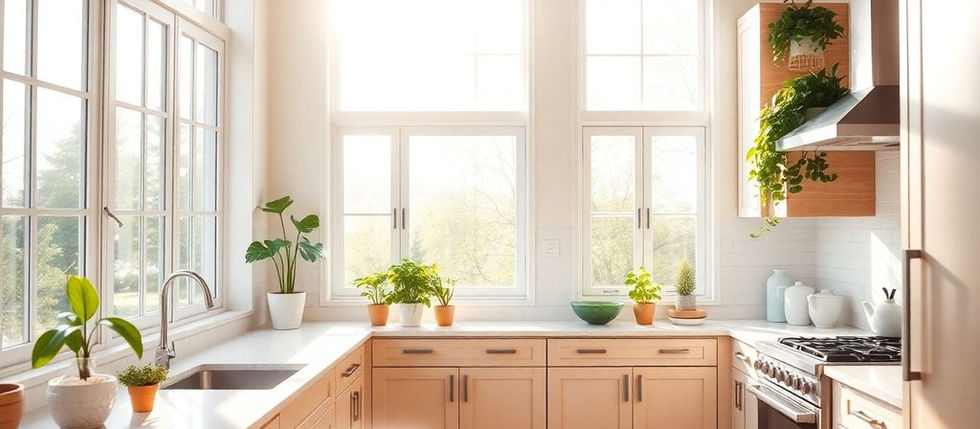Remodeling your kitchen with eco-friendly practices is a great way to create a beautiful space while also caring for the environment. This guide will help you understand how to make smart choices that benefit both your home and the planet. From choosing sustainable materials to using energy-efficient appliances, you can transform your kitchen into an eco-friendly haven.
Key Takeaways
Opt for sustainable materials like bamboo and recycled glass for countertops.
Use energy-efficient appliances to save on utility bills and reduce energy use.
Incorporate natural light through windows and skylights to brighten your kitchen.
Choose low-flow faucets and water-efficient dishwashers to conserve water.
Select non-toxic paints and finishes to improve indoor air quality.
Choosing Sustainable Materials for Your Kitchen
When remodeling your kitchen, selecting eco-friendly materials is crucial. This choice not only benefits the environment but also improves indoor air quality. Here are some key areas to focus on:
Sustainable Countertop Options
Quartz: Durable and easy to clean, quartz is a popular choice. It’s made using eco-friendly methods.
Recycled Glass: This option adds a unique look to your kitchen while being environmentally conscious.
Bamboo: A rapidly renewable resource, bamboo is stylish and strong.
Non-Toxic Kitchen Cabinets and Paints
For a healthier kitchen, choose cabinets made from reclaimed wood or FSC-certified hardwoods. These materials are not only durable but also help reduce waste. Additionally, opt for paints labeled as non-toxic to ensure cleaner air in your home.
Eco-Friendly Flooring Choices
Cork: Comfortable and sustainable, cork flooring is a great choice for kitchens.
Linoleum: Made from natural materials, linoleum is biodegradable and versatile.
Bamboo Flooring: This option is stylish and strong, making it a popular choice for eco-conscious homeowners.
In summary, when planning your kitchen remodel, consider using top eco-friendly cabinet materials like reclaimed wood, FSC-certified hardwoods, recycled composites, and low-VOC MDF. These options combine durability with environmental consciousness, ensuring your kitchen is both functional and sustainable.
Incorporating Energy-Efficient Appliances and Lighting
When remodeling your kitchen, choosing energy-efficient appliances and lighting is crucial. These choices not only help the environment but also save you money on utility bills. Here are some key points to consider:
Benefits of Energy Star Appliances
Energy Star appliances use less energy than standard models.
They can significantly lower your electricity bills over time.
Investing in these appliances is a smart choice for a sustainable kitchen.
Choosing LED Lighting Solutions
Switch to LED bulbs to reduce energy consumption.
LED lights last longer and use less power than traditional bulbs.
Consider installing dimmer switches or motion sensors to save even more energy.
Smart Technology Integration
Smart appliances can optimize energy use based on your habits.
They allow you to control your kitchen devices remotely, enhancing convenience.
Integrating smart technology can lead to a more efficient and eco-friendly kitchen.
In summary, focusing on energy efficiency in your kitchen remodel is a step towards a more sustainable lifestyle. Investing in the right appliances and lighting can transform your home into an eco-friendly haven.
Maximizing Natural Light and Ventilation
Installing Energy-Efficient Windows
To make your kitchen bright and inviting, consider installing energy-efficient windows. These windows help keep your home warm in winter and cool in summer, while also letting in plenty of natural light. Choosing larger windows can significantly enhance the brightness of your kitchen.
Utilizing Skylights for Daylight
Skylights are a fantastic way to bring in more sunlight. They can transform a dark kitchen into a cheerful space. When placed correctly, skylights can reduce the need for artificial lighting during the day, making your kitchen more energy-efficient.
Enhancing Airflow with Eco-Friendly Ventilation
Good airflow is essential for a healthy kitchen. Here are some tips to improve ventilation:
Install exhaust fans to remove cooking odors and moisture.
Use natural ventilation by opening windows when weather permits.
Consider a whole-house ventilation system for better air quality.
By focusing on these elements, you can create a kitchen that feels open and fresh, while also being eco-friendly. Incorporating these features will enhance your kitchen's overall appeal and functionality.
Water Conservation in Kitchen Design
Water conservation is essential for creating an eco-friendly kitchen. By implementing smart design choices, you can significantly reduce water usage while maintaining functionality and style.
Selecting Low-Flow Faucets and Fixtures
Install low-flow faucets to minimize water consumption without sacrificing pressure.
Choose water-efficient dishwashers that use less water per cycle.
Consider dual-flush toilets to save water in your kitchen and bathroom.
Implementing a Greywater System
A greywater system allows you to reuse water from sinks and dishwashers for irrigation.
This system can help reduce overall water usage in your home.
Ensure proper installation to comply with local regulations.
Choosing Water-Efficient Dishwashers
Look for dishwashers with an Energy Star rating, which indicates lower water usage.
Newer models often use less water while providing better cleaning performance.
Upgrading can lead to significant savings on your water bill.
By focusing on these strategies, you can create a kitchen that is both functional and environmentally friendly, contributing to a sustainable future. Remember, every drop counts!
Waste Reduction Strategies for Your Remodel
When planning your kitchen remodel, it's essential to think about how to reduce waste. Making smart choices can significantly lower the amount of waste generated during your renovation. Here are some effective strategies:
Recycling and Reusing Materials
Donate old appliances and cabinets instead of throwing them away.
Repurpose materials like wood or tiles for new projects.
Use reclaimed materials to give your kitchen a unique look while being eco-friendly.
Composting Kitchen Waste
Set up a compost bin for food scraps and organic waste.
Use compost to enrich your garden soil, reducing the need for chemical fertilizers.
Educate your family about what can be composted to maximize waste reduction.
Choosing Low-Impact Construction Methods
Opt for local contractors who prioritize sustainable practices.
Select materials that are easy to recycle or have a low environmental impact.
Plan your remodel to minimize the amount of demolition required, which can lead to less waste.
In summary, implementing these waste reduction strategies during your remodel can lead to a more eco-friendly kitchen. Remember, every small step counts towards a greener future!
Creating a Healthier Kitchen Environment
When you start a kitchen remodel, it’s important to think about more than just how it looks. Creating a breathable kitchen environment is essential for everyone who spends time there. This means choosing non-toxic materials that help keep the air clean. We should look for finishes that have low or no VOCs, which are harmful chemicals that can affect our health.
Here are some key points to consider:
Use low-VOC materials for paints and finishes.
Choose cabinets made from reclaimed wood or sustainably sourced materials.
Opt for countertops made from recycled materials like glass or quartz.
By working with suppliers who prioritize sustainability, we can ensure that our kitchen is not only beautiful but also good for the planet. Every small step we take helps reduce our environmental impact.
In summary, a healthier kitchen environment is achieved by:
Selecting non-toxic materials.
Improving indoor air quality with proper ventilation.
Using eco-friendly cleaning products that are safe for your family.
By focusing on these aspects, we can transform our kitchens into safe havens that promote well-being and sustainability.
Planning for a Timeless and Accessible Design
When remodeling your kitchen, it's essential to think about a design that will last. A timeless kitchen is not just about style; it’s about functionality and accessibility for everyone. Here are some key points to consider:
Designing for Longevity
Choose materials that are durable and easy to maintain.
Opt for classic colors and styles that won’t go out of fashion.
Consider timeless designs that can adapt to future trends.
Ensuring Accessibility for All
Make sure pathways are wide enough for wheelchairs or walkers.
Install cabinets and appliances at heights that are easy to reach.
Use lever-style handles instead of knobs for easier access.
Incorporating Flexible Layouts
Design an open floor plan that allows for easy movement.
Include adjustable shelving and movable islands for versatility.
Plan for multi-functional spaces that can change with your needs.
By focusing on these aspects, you can create a kitchen that is both stylish and practical, ensuring it remains a cherished part of your home for many years. Remember, a kitchen that is designed with accessibility in mind will serve everyone better, making it a welcoming space for all family members and guests.
Incorporating these ideas will help you achieve a kitchen that is not only efficient but also reflects your personal style while being mindful of the environment. This approach aligns with the principles of sustainable design, as seen in the hartford kitchen remodel: efficiency meets style.
Conclusion
In closing, transforming your kitchen into an eco-friendly space is a rewarding journey. By making thoughtful choices in your remodel, you not only create a beautiful area but also show your love for the planet. Each step you take, from selecting sustainable materials to using energy-efficient appliances, contributes to a healthier environment. This guide serves as a helpful tool for anyone looking to make their kitchen greener. Remember, every small change counts, and together, we can make a big difference for future generations. Let your kitchen reflect your commitment to a sustainable lifestyle, making it a place where you can cook, gather, and care for the earth.
Frequently Asked Questions
What are the first steps to start an eco-friendly kitchen remodel?
Begin by talking to experts in green remodeling. Then, choose sustainable materials and energy-saving options to reduce your kitchen's environmental impact.
Why should I choose sustainable materials for my kitchen?
Sustainable materials are better for the planet and can improve the air quality in your home. They help reduce waste and promote healthier living.
What are Energy Star appliances, and why are they important?
Energy Star appliances use less energy than standard models, which can lower your utility bills and reduce greenhouse gas emissions.
How can I save water in my kitchen?
You can save water by using low-flow faucets and fixtures, and by choosing water-efficient dishwashers that use less water.
What are some ways to reduce waste during a kitchen remodel?
Consider recycling and reusing materials, composting kitchen waste, and choosing construction methods that have less impact on the environment.
How can I create a healthier kitchen environment?
To create a healthier kitchen, use low-VOC materials, improve indoor air quality, and select non-toxic cleaning products.















Comments